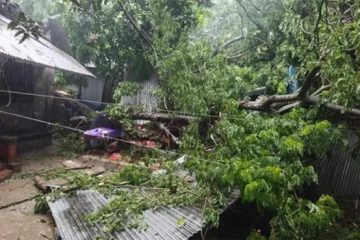318 buildings defied height limit; Rajuk asked owners in vain to knock down over 100 structures in 2007
 Over 300 buildings including high-rises have been constructed in violation of the country’s aviation rules around the Zia International Airport (ZIA) and Tejgaon Airport making take-off and landing of planes risky.
Over 300 buildings including high-rises have been constructed in violation of the country’s aviation rules around the Zia International Airport (ZIA) and Tejgaon Airport making take-off and landing of planes risky.
Rajdhani Unnayan Kartripakkha (Rajuk) in 2007 issued notices to the owners of over 100 buildings including 45 high-rises asking them to knock down the illegal portions of the buildings.
But no further progress was made in this regard as the government formed a committee to review the list of the illegal structures the same year.
An official of Civil Aviation Authority of Bangladesh (CAAB) said they along with three other organisations — the Survey of Bangladesh, Rajuk, REHAB — and the Air Force in April 2008 identified 318 structures including high-rises that had been constructed violating CAAB rules.
Of those, 72 buildings including 10 high-rises are around ZIA and 247 around Tejgaon Airport while 20 structures are risky for both the airports, said the CAAB official.
The committee formed to review the list submitted its report to the civil aviation ministry during the tenure of the last caretaker government with suggestion for not constructing the second runway at ZIA.
The report said if the second runway is constructed, a large number of structures have to be knocked down, said an official of the housing and public works ministry.
However, the CAAB representatives in the committee disagreed, he said.
Ministry sources said another committee might be formed in this regard.
Rajuk in 2005 identified 111 structures including 46 high-rises and took initiative to demolish 17 buildings in August, 2005. But eight of them could not be knocked down due to legal tangles.
Rajuk could not demolish the illegal portions of the other structures as the owners of many of the 111 buildings obtained stay order against the drive from the High Court, said a Rajuk official.
Civil Aviation and Tourism Minister GM Quader said they have already requested the authorities concerned to take necessary steps to knock down the upper portion of the structures that were constructed violating the CAAB rules.
Now it is their responsibility to knock down those, he said.
The minister said if the authorities concerned don’t take action they would take up the matter to the top level of the government.
State Minister for Housing and Public Works Abdul Mannan Khan said they would take necessary steps in this regard as per the rules.
“We have already given instructions to all the agencies concerned under the ministry to do their tasks following the rules strictly,” he said.
According to the regulations of the International Civil Aviation Organisation (ICAO), the height of structures is restricted to a certain level around the airport to prevent accidents and ensure smooth operation of flights, said CAAB officials.
They said every building in the city should be built on receipt of clearance from the CAAB. Rajuk should not approve any construction plan without its clearance.
Rajuk officials claimed that they have never approved any construction plan without CAAB’s clearance.
Owners of high-rise structures often violate the Rajuk-approved plan after receiving permission. If Rajuk tries to take action against them they take up the matter to the court to delay the process, said a Rajuk official.
Illegal structures at Baunia on the northern side of the only runway at ZIA are creating problems for flight operation and spoiled the scope for constructing a parallel runway shown in ZIA’s master plan, CAAB sources said.
If construction of the second runway at ZIA is taken into consideration, the number of structures non-compliant to the CAAB rules would be between 2000 and 3000.
According to the ICAO regulations, an area of 3,000 feet from each end of a runway should be considered ‘zero-height’ area and from that point only one foot of height is allowed for each 50 feet of distance till 10,500 feet from both ends of the runway.
But no structure should cross a height of 150 feet within the area, say the regulations.




















